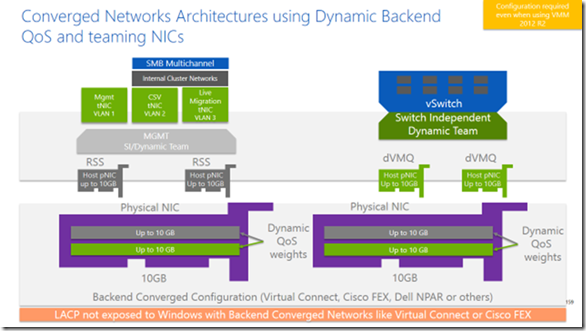Hyper-V 2012 R2 Network Architectures (Part 8 of 7) – Bonus
Hi again, this post was not planned but today one MVP (Hans Vredevoort https://www.hyper-v.nu/ ) explained me an additional Backend architecture option that is also recommended. He did a similar diagram to represent this option, so let’s figure out what is different.
This configuration is slightly different compared with the Dynamic Backend QoS in part 5 because is simplifying the Backend configuration and only presenting 4 Multiplexed adapters to Windows. Once this is done, you just need to create a TEAM with two of these adapters for all the networks required on the parent partition, like Mgmt, CSV and Live Migration.
On top of the TEAM, you have to create a tNIC (Teaming NIC) for each traffic with the corresponding VLAN. This gives isolation between traffics and control from the OS, while allowing to dynamically create more tNICs if needed without having to reboot the Hyper-V host. (you may need additional tNICs for SMB for example)
Everything can be managed either by PowerShell or the NIC TEAM Console (lbfoadmin.exe) and of course RSS will give you the best possible performance from the adapters presented by the backend.
The TEAM and the vSwitch configuration on the right side of the diagram is identical to the Dynamic Backend QoS discussed in part 5, so the VMs/Tenants traffic is completely isolated from Mgmt, CSV and Live Migration traffics.
One caveat on this configuration is the QoS for each parent partition network traffic type. How I can prioritize Mgmt over CSV or viceversa? I would answer this questions with another question… do you really need to prioritize the traffic of your tNICs when there is already a QoS policy at the backend that will guarantee at least the amount of bandwidth that you define?
Is it true that in part 5 architecture each parent partition traffic will have his own QoS in the backend, but it is also true that the sum of them can be equivalent to what you may want to reserve when using the tNICs approach.
Many thanks to Hans Hvredevoort for the architecture reference.
